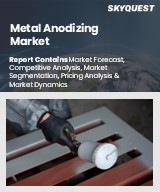
세계의 아노다이징(양극산화처리) 시장 규모는 2023년에 319억 달러로 평가되며, 예측 기간(2025-2032년)의 CAGR은 4.7%로, 2024년 334억 달러에서 2032년에는 482억 3,000만 달러로 성장할 전망입니다.
세계 아노다이징 시장은 항공우주, 자동차, 건설 등의 분야에서 내식성, 경량성, 미려한 외관을 갖춘 금속 부품에 대한 수요가 증가함에 따라 큰 폭으로 성장하고 있습니다. 지속가능한 건축 동향과 전기자동차 시장의 급격한 성장으로 인해 내구성이 뛰어난 알루미늄 부품에 대한 수요가 증가하고 있습니다. 또한 규제 압력으로 인한 친환경 코팅으로의 전환은 특히 미적 마감이 중요한 가전제품 및 가전제품에서 양극산화 처리 공정의 광범위한 채택을 촉진하고 있습니다. 그러나 이 산업은 알루마이트 처리 설비와 관련된 높은 자본 비용과 운영 비용, 엄격한 환경 규제 대응, 변동하는 원자재 가격, 대체 금속 마감 기술과의 경쟁 등의 문제에 직면해 있으며, 산업 확대에 걸림돌이 될 수 있습니다.
Global Metal Anodizing Market size was valued at USD 31.9 billion in 2023 and is poised to grow from USD 33.4 billion in 2024 to USD 48.23 billion by 2032, growing at a CAGR of 4.7% during the forecast period (2025-2032).
The global metal anodizing market is experiencing significant growth driven by increasing demand for corrosion-resistant, lightweight, and visually appealing metal components across sectors such as aerospace, automotive, and construction. The rising trend of sustainable architecture and the burgeoning electric vehicle market are amplifying the need for durable aluminum parts. Furthermore, the shift toward eco-friendly coatings due to regulatory pressures is fostering broader adoption of anodizing processes, particularly in consumer electronics and household appliances, where aesthetic finishes are crucial. However, the industry faces challenges, including high capital and operational costs associated with anodizing facilities, compliance with stringent environmental regulations, fluctuating raw material prices, and competition from alternative metal finishing techniques, which could potentially hinder its expansion.
Top-down and bottom-up approaches were used to estimate and validate the size of the Global Metal Anodizing market and to estimate the size of various other dependent submarkets. The research methodology used to estimate the market size includes the following details: The key players in the market were identified through secondary research, and their market shares in the respective regions were determined through primary and secondary research. This entire procedure includes the study of the annual and financial reports of the top market players and extensive interviews for key insights from industry leaders such as CEOs, VPs, directors, and marketing executives. All percentage shares split, and breakdowns were determined using secondary sources and verified through Primary sources. All possible parameters that affect the markets covered in this research study have been accounted for, viewed in extensive detail, verified through primary research, and analyzed to get the final quantitative and qualitative data.
Global Metal Anodizing Market Segments Analysis
Global Metal Anodizing Market is segmented by Process, Application, Finish and region. Based on Process, the market is segmented into Chromic Acid Anodizing, Sulphuric Acid Anodizing and Hard Anodizing. Based on Application, the market is segmented into Automotive, Architecture, Electronics and Medical. Based on Finish, the market is segmented into Clear Anodized, Colored Anodized and Patterned Anodized. Based on region, the market is segmented into North America, Europe, Asia Pacific, Latin America and Middle East & Africa.
Driver of the Global Metal Anodizing Market
The growing emphasis on sustainable architecture is significantly boosting the Global Metal Anodizing market by driving the demand for durable, corrosion-resistant, and low-maintenance aluminum finishes frequently used in eco-friendly buildings. Architects and developers are increasingly selecting anodized materials for energy-efficient window systems and facades that adhere to environmental standards. This trend not only meets the rising consumer preference for green construction but also aligns with regulatory initiatives promoting sustainability, thereby facilitating the wider adoption of anodizing in contemporary urban development projects. As a result, the metal anodizing sector is experiencing robust growth in response to these evolving market requirements.
Restraints in the Global Metal Anodizing Market
The Global Metal Anodizing market faces significant challenges due to stringent environmental regulations governing chemical waste management and wastewater treatment. These regulations lead to elevated compliance costs for anodizing companies, necessitating investments in advanced filtration systems, neutralization technologies, and secure handling procedures for chemicals. As a result, profit margins are often squeezed, particularly for smaller businesses trying to compete. This regulatory landscape not only pressures traditional practices but also encourages a shift towards cleaner anodizing technologies to meet sustainability demands and adapt to increasingly rigorous governmental standards, particularly in more developed regions.
Market Trends of the Global Metal Anodizing Market
The Global Metal Anodizing market is witnessing a significant shift towards eco-friendly anodizing technologies, driven by increasing environmental awareness and stringent regulatory frameworks worldwide. This trend is characterized by the adoption of innovative solutions such as chrome-free sealing and water-based electrolytes, which aim to reduce hazardous waste and enhance workplace safety. Industries such as automotive, aerospace, electronics, and construction are increasingly prioritizing sustainable manufacturing practices, leading to a surge in demand for green anodizing solutions. This focus on environmentally responsible methods is expected to substantially reshape the market landscape, promoting cleaner production and compliance with evolving industry standards.